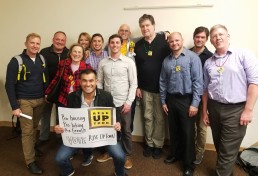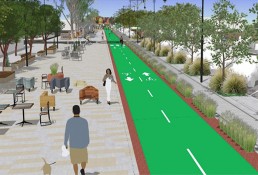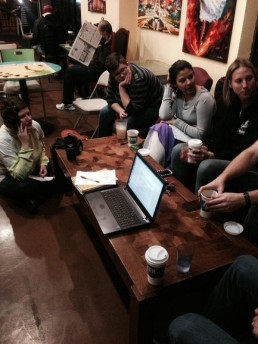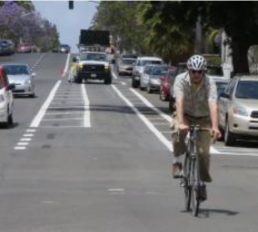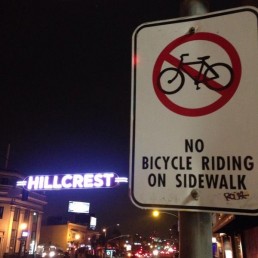Update: Pro-bike and housing candidates win Uptown Planners election
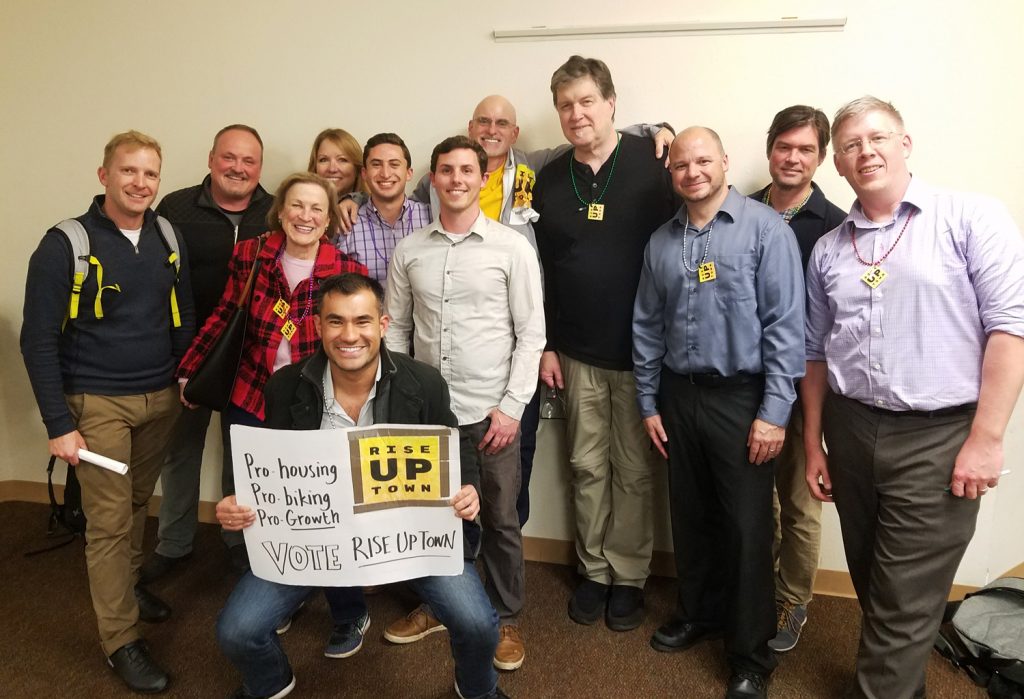
 A major victory on March 5, 2019, for RISE UP TOWN, a slate of seven pro-housing, pro-biking, pro-walking, pro-transit candidates on the ballot for Uptown Planners board. This race offered a rare opportunity to shift the direction of this community board by bringing pro-housing/biking voices to a majority on the board. BikeSD members and allies who live (or owns a business or property) in Hillcrest, Mission Hills, Bankers Hill, UC Medical area, Middletown, and University Heights were urged to come out and vote. More from the KPBS story here: https://www.kpbs.org/news/2019/mar/06/density-urbanists-uptown-planners-yimby-housing/
A major victory on March 5, 2019, for RISE UP TOWN, a slate of seven pro-housing, pro-biking, pro-walking, pro-transit candidates on the ballot for Uptown Planners board. This race offered a rare opportunity to shift the direction of this community board by bringing pro-housing/biking voices to a majority on the board. BikeSD members and allies who live (or owns a business or property) in Hillcrest, Mission Hills, Bankers Hill, UC Medical area, Middletown, and University Heights were urged to come out and vote. More from the KPBS story here: https://www.kpbs.org/news/2019/mar/06/density-urbanists-uptown-planners-yimby-housing/
Normal Street Promenade Workshop - Thursday, January 24, 6:00 PM

The Normal Street Promenade will be a new public space in Hillcrest along Normal Street between University Avenue and Washington Street and will be the first transit-oriented pedestrian promenade in San Diego.
 To develop the final concept, the City of San Diego and SANDAG will work with the community through a series of workshops. The conference room at Joyce Beers Community Hall will have different stations showing the bare bones concept and then a visual preference station showing options for lighting, landscaping, etc.
To develop the final concept, the City of San Diego and SANDAG will work with the community through a series of workshops. The conference room at Joyce Beers Community Hall will have different stations showing the bare bones concept and then a visual preference station showing options for lighting, landscaping, etc.
The first workshop will be held:
DATE: Thursday, January 24th
TIME: 6:00-9:00 p.m.
LOCATION: Joyce Beers Hall, 3900 Vermont St, San Diego
Please be sure to join fellow residents and learn more about this upcoming project. More background on our earlier report on the Normal Street Promenade here.
BikeSD Uptown Committee Meeting Recap
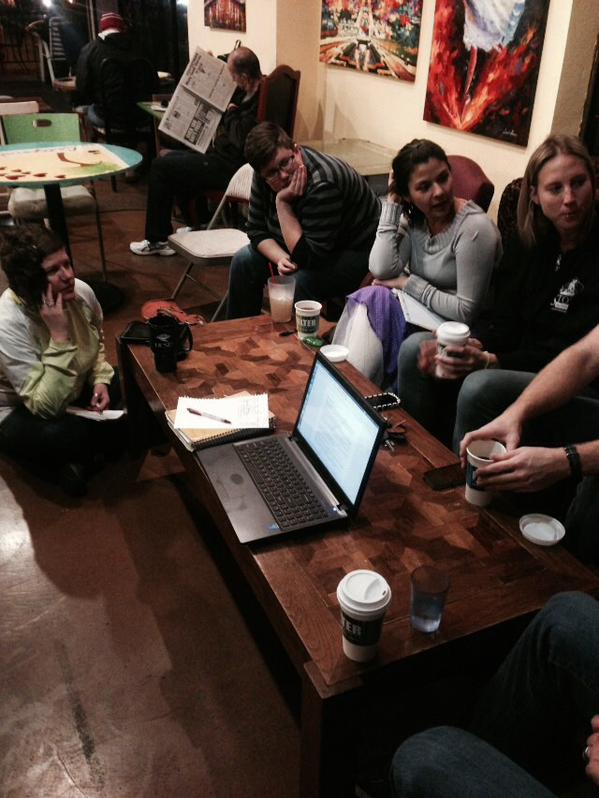 Some of the BikeSD Uptown Committee Meeting Attendees
Some of the BikeSD Uptown Committee Meeting Attendees
Monday night, BikeSD held the first meeting of its Uptown Committee. Uptown is a very important community for walkability and bikeability in San Diego. Home to many popular late-night businesses, it is also a major crossroads of the city. Streets like University and Washington connect neighborhoods like City Heights and North Park to the beaches while the numbered avenues bring traffic from Downtown and Little Italy up the mesa. Yet Uptown has not been a strong force for transportation progress. Plans to create a bikeable, pedestrian friendly corridor along University Avenue have been met with strong resistance, and the unobtrusive bike lanes on parts of 4th and 5th have drawn unfortunate backlash. The goal of the Uptown Committee is to organize the residents of Uptown, both to highlight the concerns and needs of residents and to create action plans to resolve those needs.
The map below shows the boundaries of Uptown, shaded in red, including the east/west and north/south corridors that are our primary focus.
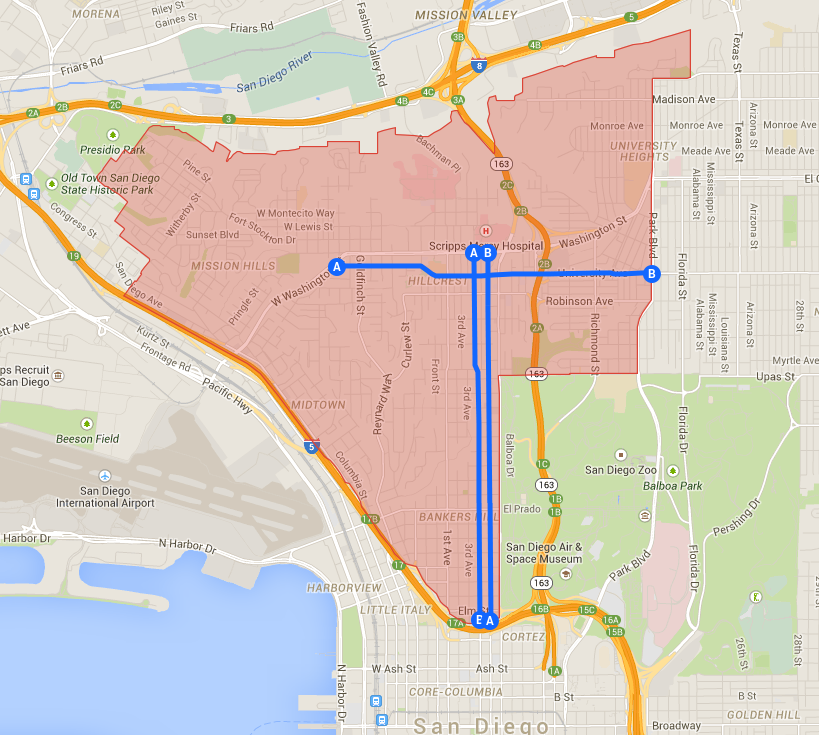
Broad Interest
The meeting brought in several residents of Uptown, as well as some former residents and residents of nearby neighborhoods. Coming from diverse backgrounds, the attendees originally hailed from as far as the eastern US and Canada and as near as San Diego itself. They were all drawn to this meeting with a desire to improve the community they now call home, Uptown. The committee is a project of BikeSD board member and Hillcrest resident Dre Sparks, who decided to organize Uptown specifically after years of seeing the difficulty in the neighborhood first hand.
Dangerous Corridors
BikeSD’s executive director, Sam Ollinger, helped start the meeting with a description of Vision Zero, a movement to reduce traffic fatalities that has been gaining traction in major American cities. Important for the residents of Uptown, University Avenue has been identified, by CirculateSD, as the most dangerous corridor in San Diego. All those in attendance at the meeting piped in with times they felt unsafe on University Avenue.
The general consensus seemed to be that there was no good east-west bike route through Uptown. Some mentioned that they have moved to Robinson after frightening experiences on University, while others mentioned dangerous road conditions and freeway ramps on Robinson pushing them to University. One attendee mentioned only feeling comfortable on the sidewalk through this section of town. Because of the concentration of businesses and the lack of full-length streets, University seemed to be the eventual destination of all cyclists; it just cannot be avoided.
The discussion brought together some of my personal experiences in a way I had not considered before. While I do ride on University to save time or reach businesses on University, it occurred to me that I never take guests from out of town on the street. I have done this without consciously thinking about it, always leading visitors westward through Mission Hills and into other neighborhoods. I have not asked my friends and family about this; perhaps they think there is nothing to see in Hillcrest!
Chicken and Egg
There were mixed feelings about the upcoming introduction of Decobike. While everyone seemed excited about the new bike share program, a few residents expressed concern that usage might not be high enough to support the system, given the lack of strong bike infrastructure. Residents with past experience in Montreal and New York suggested that good infrastructure made the bike share programs into obvious successes.
All was not doom and gloom, however. It was noted that the bike share itself could be a driver of increased road safety. Not only might it further infrastructure development, but an increase to the number of bikes on the road would cause drivers to pay more attention and maneuver more safely.
Getting Attention
The most influential group in Uptown is Uptown Planners Community Planning Group, the city recognized advisory group on all issues related to community planning and development Though often harboring the best of intentions, the Uptown Planners are unfortunately narrow in their awareness of the needs of many Uptown residents. The Planners will meet next on February 3rd at the Joyce Beers Community Center, on Vermont Street. Meetings are generally called to order at 6 pm.
Our meeting quickly turned to a discussion of the Uptown Planners. While all Uptown residents can attend and have their voices heard, becoming a board member requires a more substantial commitment. We discussed the requirement to attend at least 3 meetings in the year leading up to elections, a requirement I was surprised to hear is not present in the most other community planning groups. Several people, all working professionals, discussed how difficult it can be to get back into the neighborhood by the 6 pm start time, making it difficult to get involved.
The Future
The next BikeSD Uptown Committee meeting will be held at 7 pm on February 16th. We will be meeting at Filter, at the corner of University Avenue and Richmond Street. All residents of Uptown who wish to see an increased focus on bike infrastructure and safety are welcome to attend and join the conversation. You may sign up to receive updates on the Uptown Campaign page as well.
The neighborhoods of Uptown have largely shifted toward pedestrian and bike traffic, increasingly focusing on nightlife and small shops and containing reasonably high density for San Diego. With an organized message, we can make a push to finish the job and have the infrastructure catch up!
---
Erik Dorthe is a BikeSD member and a resident of Hillcrest.
On Monday 10/20: City to Present Plan to Extend 4th and 5th Buffered Bike Lanes; Leo Wilson Continues his Campaign Against Bicycling
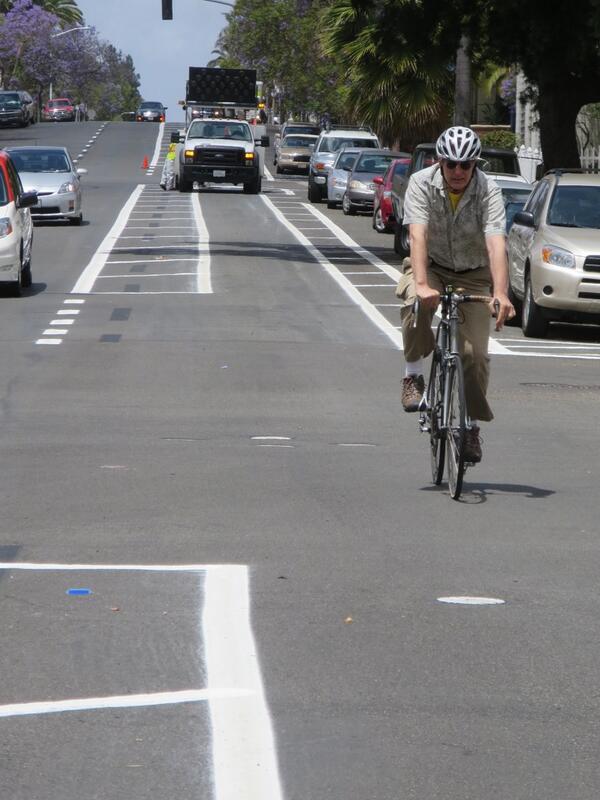
Photo by Adrian Granda of the buffered bike lane that currently ends at Laurel St.
Next Monday at 6:30 PM, the city will be presenting a plan to extend the new 4th and 5th bike lanes from Laurel Street. If you live or travel through Bankers Hill you should be there. Brian Genovese (City Engineer) is presenting 4th and 5th Avenue bike lane extension through Bankers Hill at:
3030 Front Street (Bankers Hill Social Club) on Monday at 6:30 PM (October 20th).
If you'd like to ride to the Bankers Hill Social Club, a group is leaving Balboa Park at 5:30 PM.
Opponents (such as Uptown Chair Leo Wilson – whom we’ve asked to step down as Chair) are claiming that the city needs to do a environmental analysis in order to add a bike lane. In an email sent earlier this week, Wilson writes:
Attached is a copy of the San Diego Bicycle Plan. Page 138 has the bicycle plan's recommendations for 4th and 5th Avenues in Bankers Hill.The recommendations are for Class II and Class III bicycles lanes -- not a Class I type of bike route that would require the removal of traffic lanes. Instead the bicycle plan (p. 138) indicates it "would be necessary to narrow the existing traffic lanes to 11 feet and narrow the existing parking lane to 7 feet to provide necessary space for Class II bike facilities along 4th and 5th Avenues." It does not recommend lane reductionsThe City's claim they can remove traffic lanes based on the recommendations of the City's approved bicycle master plan are erroneous. There needs to be CEQA review, and an amendment to the bicycle plan involving a community review process.
That's right. San Diego has its own Rob Anderson and his name is Leo Wilson.
Making room for a bike lane by reducing and existing travel lane doesn't result in a Class I bike path (examples being the Harbor Drive multi-use path or the Bayshore Bikeway). If anything, narrowing existing travel lanes will result in the city creating a Class II bike lane (marked by paint stripes on asphalt with painted buffer hatch marks). With some sustained effort, our advocacy will result in eventually converting that Class II bike lane into a cycletrack or a Class IV facility, recently approved by the Governor, thanks to the California Bicycle Coalition.
Furthermore, last year the Governor signed a bill into law exempting bike lanes from CEQA (The California Environmental Quality Act). In other words, Wilson is wrong.
As an update to the petition calling for Leo Wilson to step down as chair to the Uptown Planners I asked Marlon Pangilinan, a city planner who oversees Uptown, a few questions and he provided me with some clarification on the rules about Community Planning Group members. The responses are below:
1. Are there rules on how long a member of a planning group can serve both on the board and as chair?
Yes. According to Council Policy 600-24 which provides the standard operating procedures and responsibilities for the City’s recognized Community Planning Groups (CPG), no person may serve on a planning group for more than eight consecutive years if members are elected to two- or four-year terms, or nine consecutive years if members are elected to three-year terms.The eight or nine year limit refers to total service time, not to individual seats held. After a one-year break in service as a planning group member, an individual who had served for eight or nine consecutive years shall again be eligible for election to the committee. There are exceptions to serving more than the 8 to 9 year limit in the case there are not enough members to fill vacant seats.
In the case of the Uptown Planners, their approved bylaws dictate fixed terms of 4 years, therefore the maximum time an individual can serve on the Uptown Planners is 8 years.
The Chair is an officer position on the Uptown Planners. The length of the officer’s term is one year. However, officers are elected annually from the and by the members of the Uptown Planners, so the same individual can be voted to fill the same officer position every year except that no person may serve in the same Uptown Planners office position for than 8 consecutive years.
2. What are the consequences for violation if there are rules?
If a violation is proven, the CPG must take corrective action. A planning group member or planning group found to be out of compliance with the provisions of Council Policy 600-24, or the planning group’s adopted bylaws, risks loss of indemnification (legal protection and representation) and forfeiture of its status as recognized advisory body.3. Has there been an effort to unseat a Planning Group chair in the past? What has the result been?
No. Based on my recent discussions with other Community Planners in the Planning Department, there have been complaints regarding the way CPG Chairs run the meetings and regarding Chairs with perceived conflicts of interest, but with no apparent or proven violations.
Hope to see you on Monday at 6:30 PM. We could sure use your presence.
Update: John Anderson has a great writeup of the meeting.
Bicycle & Livability Supporters Fear Coming Out in Hillcrest Amidst Death Threats
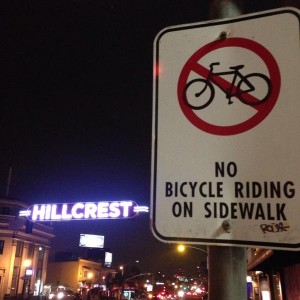 Growing up I never imagined being in a position where I'd get more flak for being someone who prefers to ride a bicycle than I would for a being a gay man.
Growing up I never imagined being in a position where I'd get more flak for being someone who prefers to ride a bicycle than I would for a being a gay man.
I get more hate directed from my fellow LGBTQ community in San Diego for being a bicycle advocate than I receive from the straight community for being queer. It reveals an interesting dichotomy of social acceptance and surprises me that such contempt emanates from our LGBTQ community.
Recently while walking in Hillcrest, I happened across a member (let's call this person “Jamie” for the purposes of this story and not outing someone's orientation) who is a leader in the LGBTQ community. This is someone I hold great love and respect for. We cordially greeted each other as usual with a smile, hug, and kiss. Jamie felt the need to inform me how much he wished I wasn’t one of those “bike people”. This quickly soured our encounter. Jamie went on to say, “one of these days I’ll probably kill you or another of your friends. I don’t want to but it won’t matter which one of us would be right or wrong – you’d be dead. Bikes shouldn’t be in the city or on the streets. We don’t want these bike lanes here, we’ve even booed [Council President] Todd Gloria for suggesting such a thing. Can’t you go ride your bike some place else”?
Even before this encounter, BikeSD executive director Sam Ollinger faced similar backlash from another LGBTQ business leader and community figurehead. Ollinger was going around talking to local businesses about how they could support our advocacy efforts to improve and enhance bicycling in Hillcrest. At one establishment the co-owner wished death on people riding bicycles to "teach them a lesson" - all because he's occasionally seen bicycle riders roll through stop signs.
I don't know about you, but I would never wish harm or death against anyone driving a car just because I've witnessed drivers using their phone while driving, or violating the law while rolling through a stop sign, our own infamous “California stop”. This lack of scrutiny on driver behaviour was addressed here previously.
Tens of thousands of Americans are killed each year by speeding and inattentive driving. Surely this is a far greater problem than bad behaviour from people on bikes.
Back to the encounter with Jamie. Once I recovered from the shock of realizing someone for whom I thought had mutual respect was instead callous about the value of my life and others because of our choice of transportation; I tried to explain the need for dedicated infrastructure to provide safe transportation for everyone.
At BikeSD we work hard to educate our many communities about the need and importance for proper urban infrastructure. But it's sometimes very slow going because it sometimes feels like our message falls on deaf ears. And it seems to lie in this false choice of choosing between the personal convenience of an automobile over safer streets.
Sustainability is not just a buzzword. It’s a real thing. We can’t build ever-larger streets with unlimited parking. We have to focus our design and smart growth on promoting and enhancing the mobility options for pedestrians, bicycles, wheelchair users, skateboards and everyone else in order make our communities places to get out and live. Our communities should be destinations, not convenient drive through thoroughfares like the interstate.
This piece shouldn't be taken as an over-generalization of the LGBTQ community’s response. There are some outside the LGBTQ Hillcrest who also do not support bicycle infrastructure or more livable cities for one reason or another. There are many more in the LGBTQ community that do support our efforts – yet they do so in silence for fear of being outed as a bicycle supporter. Now that’s ironic. It saddens me to see this come from our community, my community – to hear comments wishing me death that I would more expect to hear from the likes of Westboro Baptist Church. It’s odd and surprises me that people with a history of marginalization would be so quick to target others who are marginalized in their own way.
Hillcrest and the Uptown area are on the precipice of a grand redesign to the heart of our LGBTQ community. We don’t need death threats. We need infrastructure that benefits everyone. Improved sidewalks, urban parklets, and dedicated, protected bike lanes so people of any age can use their bicycles more to make urban trips and lessen their dependence on cars - which in turn lessens the traffic and the parking burden on Hillcrest. And just think of all those great legs everyone will soon have!
---
Bruce Shank served on the BikeSD board from 2013-2014 and stepped down from the board to focus on his move to Los Angeles. Bruce is moving due a job placement that was unavoidable.

